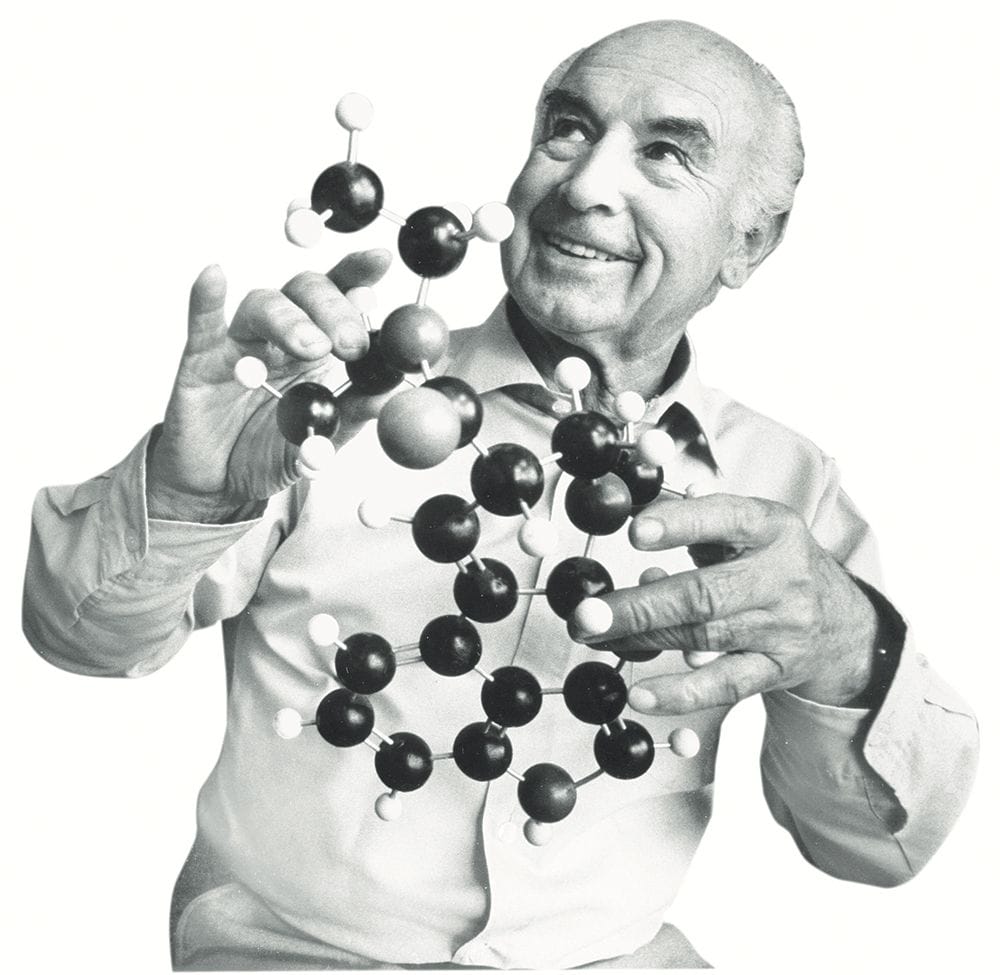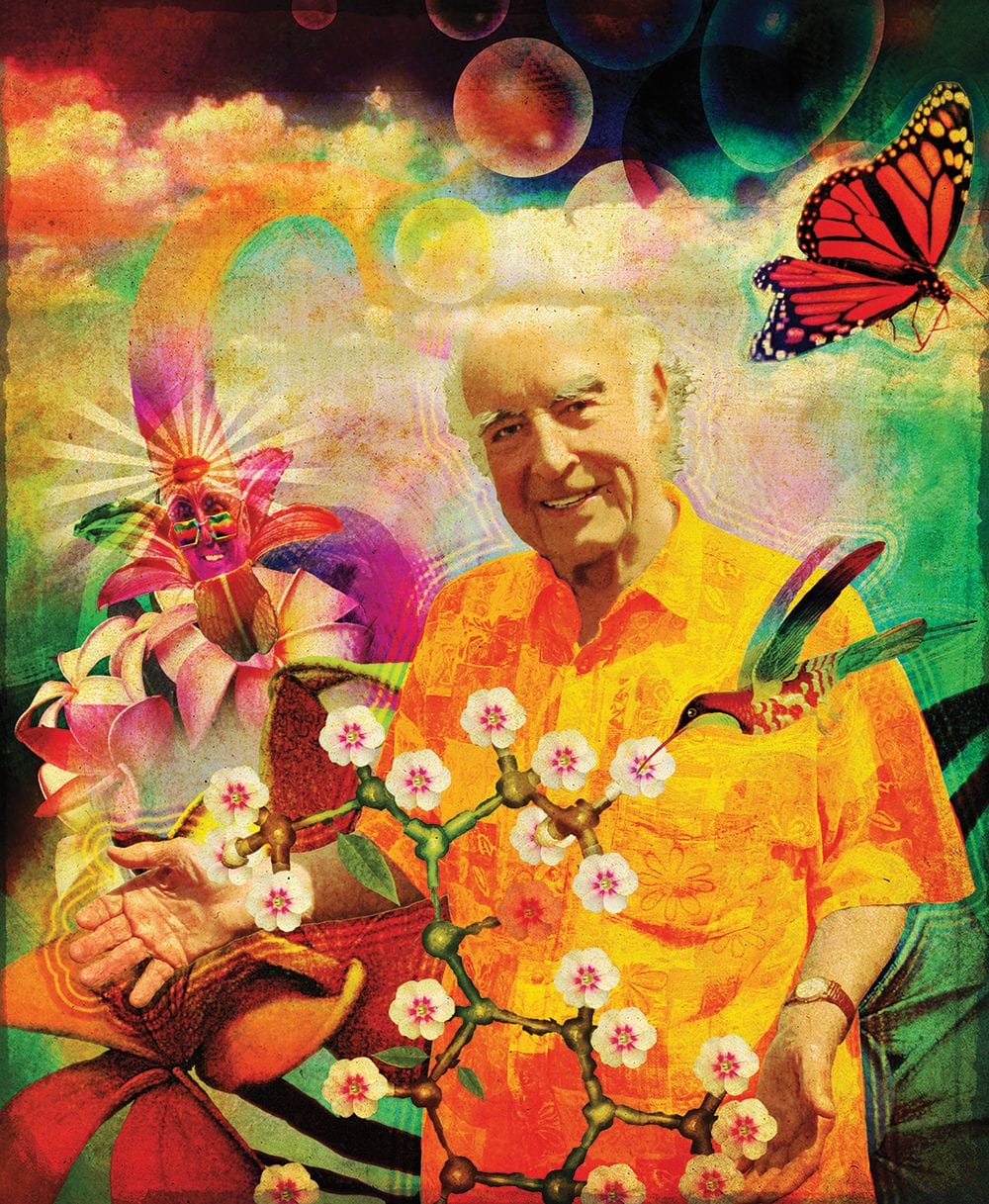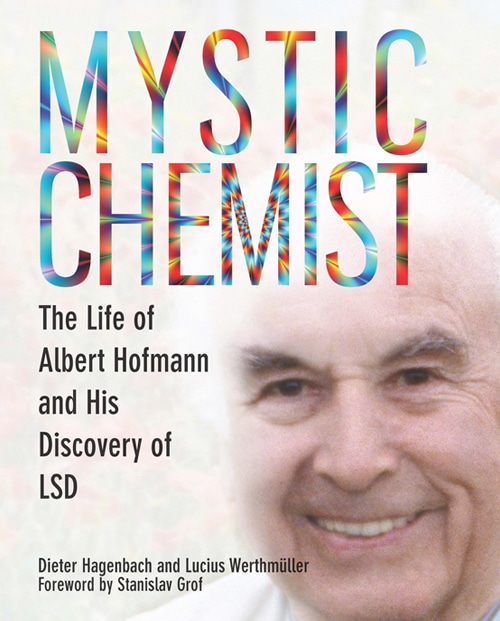In order to help you celebrate Bicycle Day 2021, we’re publishing an excerpt from the comprehensive biography on Albert Hofmann, Mystic Chemist, written by his close friends, the recently deceased Lucius Werthmüller, and the late Dieter Hagenbach, with a foreword from Stanislav Grof. Additionally, we are offering a 20% discount on the book with the coupon code “bicycleday2021”. The offer is valid until May 1st.
Bicycle Day: LSD Finds Its Discoverer
Albert Hofmann had to know and decided to undertake a series of experiments, beginning with a test on himself on April 19th, 1943. Again he proceeded with great caution and chose a dosage of 250 micrograms, the smallest amount of ergot alkaloid deemed to have a noticeable effect.
But once again, strange and, initially, decidedly frightening images overcame the chemist, this time more acutely than before. According to his lab journal, his experiment began at four twenty in the afternoon when he ingested “0.5 cc of ½ pro mil tartrate solution of diethylamide peroral = 0.25 mg tartrate. To be taken thinned with ca. 10 cc water.” At five pm he notes: “Beginning dizziness, anxiety, disturbed vision, paralysis, urge to laugh.” Two days later he adds: “Cycled home. Severest crisis from six to eight pm” and refers to a special report because he can barely record the last entry. He is at once certain that his experiences on April 16th stemmed from the unintentional ingestion of a small amount of LSD-25. The experiences were the same, but this time more intense and profound.
During the war, fuel was difficult to find. Gasoline was rationed and available for very few private vehicles. Indispensable commercial vehicles such as tractors and trucks were fitted with wood gasifiers. At that time, even in Switzerland, only a few wealthy could afford an automobile and taxis were not available. That is why Hofmann did not have someone drive him home; instead, his lab assistant, Susi Ramstein accompanied him by bicycle. He had the impression that they made little headway, but she later assured him that they cycled very fast and she had to pedal hard to keep up with him. The rows of houses took on threatening forms, the street seemed wavy, and the few persons they met changed into distorted shapes. The distance between the laboratory and his home was ten kilometers, with a few gentle inclines on the way.
Once they reached his house, Hofmann asked Ms. Ramstein to call his doctor and to bring him a glass of milk from the neighbor woman as an antidote: He feared a fatal poisoning. Dizziness and faintness alternated. Exhausted, he went into the living room and lay on the sofa. Just as on the way home, the familiar surroundings in the cozy home looked distorted and eerie. The walls and ceiling appeared to bend and arch, furniture took on grotesque forms and appeared to move. He asked for more milk. He hardly recognized the neighbor who brought him more than two liters of milk. Instead, he perceived her as “a nasty, insidious witch with a colored mask.”
Hofmann found the transformation of his inner world at least as unsettling as those in his surroundings: “All my efforts of will seemed in vain; I could not stop the disintegration of the exterior world and the dissolution of my ego. A demon had invaded me and taken possession of my body, my senses, and my soul. A terrible fear that I had lost my mind grabbed me. I had entered another world, a different dimension, a different time.” His body seemed to him without feeling, lifeless and foreign. “Was I dying? Was this the transition?” were the agonizing questions that pressed in upon him and persisted.

Albert Hofmann showcasing the molecular structure of LSD
He thought of his wife and three children who, precisely on this day, had driven to visit his in-laws in Lucerne. Would he ever see them again? Would he die without being able to say farewell? How would posterity judge him? That a young head of a family had been recklessly careless and risked leaving his young family fatherless? Had his obsession with research-driven him too far? Hofmann was certain that he had not acted carelessly, and had always conducted his research prudently. Did this mean the end of the career that had begun with such promise and meant so much to him and promised so much more? “I was struck by the irony that precisely lysergic acid diethylamide, which I had brought into the world, was now forcing me to leave it prematurely.” His situation struck him as a most appalling and terrifying, hardly comprehensible tragedy.
It seemed an eternity had gone by for him before the doctor arrived and Ms. Ramstein could report the self-experiment at the Sandoz laboratory. Although Hofmann believed the worst of his desperate experience was over, he was not able to formulate a coherent sentence. Dr. Beerli, who had come in place of Hofmann’s regular physician, Dr. Schilling, found no indications of any abnormal condition or poisoning. Respiration, pulse, and blood pressure were normal. He helped Hofmann move to the bedroom to rest, but refrained from prescribing any medicine as none seemed indicated. This reassuring diagnosis had a positive effect. Within a rather short time, the anxieties and terrifying images subsided and gave way to “feelings of happiness and thankfulness.” Hofmann began to enjoy his involuntary excursion into unknown and unfamiliar realms of consciousness. With closed eyes, he saw a wonderful play of color and forms: “a kaleidoscopic flood of fantastic images dazzled me; they circled and spiraled, opened and closed again as fountains of color, reorganizing and crisscrossing in constant flux. Particularly remarkable was how any acoustical perception, like the sound of a door handle or a passing car, transformed into optical perceptions. For each sound, there was a corresponding, vividly shifting form and color.”
By late that evening, Hofmann had recovered sufficiently to describe his remarkable adventure to his wife, Anita. She had left the children with her parents and returned home after receiving a telephone call about her husband’s breakdown. With the return of some tranquility to the Hofmann house, the exhausted chemist went to sleep. The following morning, he felt physically tired, but mentally refreshed and fit. “A feeling of well-being and new life flowed through me. Breakfast tasted marvelous, an extraordinary pleasure. When I went outside, the garden was still damp from a spring rain, and the sun made everything sparkle and gleam in fresh light. The world felt newly created. All my senses vibrated in a state of high sensitivity which lasted throughout the day.” All in all, Albert Hofmann’s experiment on himself, the first LSD trip in history, ended gently. He had discovered the most potent psychoactive substance yet known.
Hofmann’s first experience contains many elements and descriptions that would be found in thousands of later reports of comparable trips. This first self-experiment contained two decisive factors in the course of any psychedelic experience, later designated as “set and setting” by the American psychologist Timothy Leary. “Set” referred to the mental and physical state and expectation of the consumer and “setting” to the atmosphere and surroundings during the session. Hofmann’s experience became a positive one after his doctor told him that he need not fear he was on the threshold of death or permanent damage from a life-threatening poisoning. He had no frame of reference for what was happening to him and no certainty that his condition would normalize a few hours afterwards. He at least remained aware the entire time that he had undertaken a self-experiment. “The most frightening thing was that I didn’t know if I would regain my normal state of mind. It was only when the world slowly began to look normal again that I felt exhilaration, a kind of rebirth.”

Photo by Jakob Krattiger; illustration from “Das Basler Buch”
Albert Hofmann was impressed by his discovery10 and by the intensity of his experiences during that first self-experiment with LSD-25 which would long resonate for him. He knew of no other substance with such profound psychological effects at such a low dosage that so dramatically altered experience of the inner and outer worlds in human consciousness. Hofmann found it remarkable that he was able to recall details of his LSD intoxication and explained it with the hypothesis “that no matter how perturbed someone’s worldview was at the height of the trip, the part of consciousness that registers experience was unimpaired.” He was equally amazed that he remained aware of it as an experiment on himself yet was unable to voluntarily alter it and banish the “LSD-induced world.” Just as surprising and welcome was the absence of any noticeable hangover afterwards; rather he felt left in excellent physical and mental condition.
Three days later, Hofmann presented his detailed report to Arthur Stoll and Professor Rothlin, the director of the pharmacological department. “As might be expected, it met with incredulous astonishment,” he recalled. They both immediately asked him whether he had made an error in dosage. It was clear to them that no psychotropic substance was known to be that effective at a micro dosage level. The last doubts were erased only when Rothlin and Stoll both cautiously tried dosages of LSD one-third the strength of Hofmann’s trial dose and had nearly as impressive results. In subsequent trials, Hofmann never ingested a comparable dosage again and described 250 micrograms as an “overdose.” He was astonished that the “tripping generation” of the sixties considered his first dosage to be the standard measure.
His spectacular bicycle ride from the Sandoz factory through the outskirts of Basel and on beyond the city limits to his house became the stuff of legends. Since 1984, April 19th has been celebrated as “Bicycle Day” among pop-culture LSD fans. It was initiated by Thomas B. Roberts, emeritus professor of educational psychology. Americans in particular found the idea of a bike ride while on LSD amusing and admirable. Back then, hardly anybody in that land of boundless possibilities used bicycles and certainly not in the condition Hofmann was in on his original trip.
Looking back, Hofmann thought about the circumstances and significance of his discovery: “From a personal perspective, without the intervention of chance, I think the psychedelic effects of lysergic acid diethylamide would not have been discovered. It would have joined the tens of thousands of other substances that are produced and tested in pharmaceutical research every year and are relegated to obscurity for lack of effect and there would have been no LSD story.
However, in light of other significant discoveries of the time in medical and technical fields, the discovery of LSD could be considered less a matter of chance than of being called into the world as part of a higher plan.
In the 1940’s, tranquilizers were discovered and proved to be a sensation for psychiatry. As their name expresses, tranquilizers cover up emotional problems whereas LSD is at the opposite pole of pharmacology; it reveals problems, making them more accessible to therapeutic intervention.
About the same time, nuclear energy became technically usable and the atomic bomb was developed. A new dimension of threat and destruction had been created compared with earlier energy sources and weapons. That corresponds to the increase in potency in psychotropic drugs such as mescaline to LSD, of a factor of 1:5,000 to 1:10,000.
One might suppose that the discovery of LSD was not a coincidence but drawn to attention by the Weltgeist. From this perspective, that would make the discovery of LSD no longer a matter of coincidence. Further reflection might lead one to think that its discovery was predetermined by a higher force and emerged as people began to contemplate the prevalence of the materialism of the past century; LSD, an illuminating psychotropic drug, appearing on the way to a new, more spiritual age.
All of this could suggest that my initial decisions leading up to finding LSD were not a product of free will, but were guided by the subconscious mind which links us all to the universal, impersonal consciousness.”
20% Discount on Mystic Chemist

Get 20% off the paperback version of the book using the discount code “bicycleday2021”. Offer valid until May 1st, 2021.

